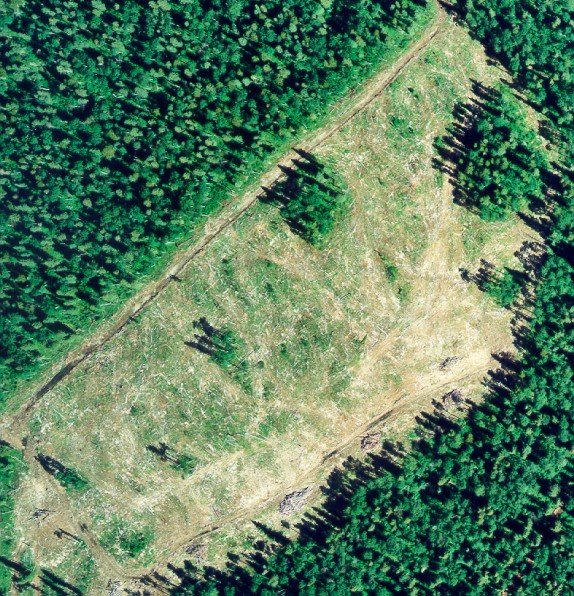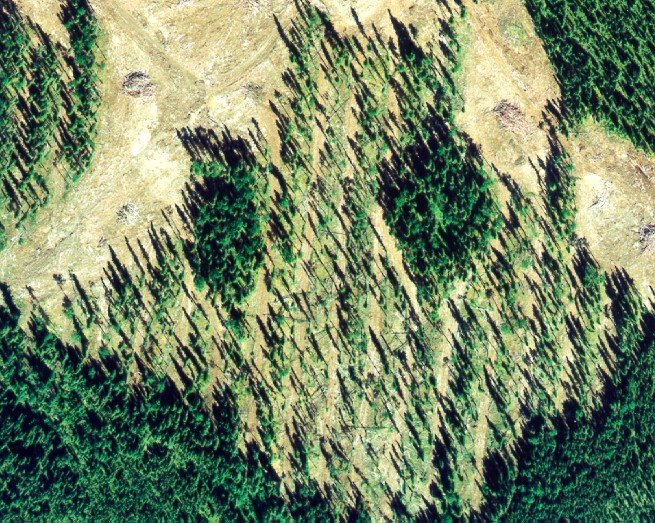
Experimental Design
The EMEND research study site is located within the Boreal Plains ecozone, approximately 90 km northwest of Peace River in Alberta, Canada. This area is characterized by mixedwood forest, a forest type abundant in Canada. The site boasts diverse vegetation and wildlife, making it an ideal location for studying sustainable forestry practices.
* The dark shaded area on the map indicates boreal plains.
Note: The experiment includes a total of 100 compartments, which encompass both harvest and fire treatments. 72 of these compartments represent the six harvest treatments replicated across the four forest types.
Harvest Treatments
Six different treatments were applied in 10-hectare compartments across EMEND. Each treatment was repeated three times in each of the four forest cover types for a total of 72 compartments.
Treatments:
2% retention
10% retention
25% retention
50% retention
75% retention
Uncut controls
*All harvested stands contain two retention patches.
The harvest treatments employed a modified uniform shelterwood pattern, which involves gradually removing mature trees to create a uniform layer of young growth beneath them. Distributed retention patterns were achieved using conventional harvesting equipment such as feller bunchers and wheeled skidders. Operations were carried out in 5-meter-wide machine corridors spaced 20 meters apart, leaving 15-meter-wide retention strips between them. Retention treatments were achieved through systematic tree removal, a process of selectively removing trees based on specific criteria. For further details on the harvesting operations and prescriptions, please read the final EMEND Harvest Layout and Extraction Plan.
Mixedwood - 2% retention
Mixedwood - 20% retention
Mixedwood - 50% retention
Fire
The experiment also included a fire component through prescribed burns, with the goal of explicitly comparing ecosystem responses between stands with retention and those originating from natural disturbances such as fire. These treatments include:
Full Stand Burns
These treatments were originally planned to be replicated three to four times for each cover type, at varying intensities. However, fewer prescribed burns were delivered than planned as the required conditions for safe burning were rarely met.
These treatments were replicated 4 times in both deciduous forest cover types and 3 times in the mixed wood and coniferous dominated forest cover types for a total of 14 compartments.
Slash Burns
These treatments were replicated three to four times for each cover type and are viewed as a supplement to the full stand burns, as the slash burns were able to be delivered in all stand types.
These treatments were replicated 3 times in both deciduous forest cover types and 4 times in the mixed wood and coniferous dominated forest cover types for a total of 14 half compartments.
Silviculture Treatments
Silviculture treatments were established in a series of 50 m x 50 m plots in the following compartments:
2%, 50% and 75% retention
deciduous-dominated and coniferous-dominated cover types
Seedling growth has been monitored and the cost and effectiveness of these silvicultural techniques have been compared with natural regeneration in the remaining portions of each compartment.
For additional information on the EMEND project, see the EMEND Overview briefing note below.
More detailed information regarding EMEND methodology and treatments for researchers and graduate students can be found here.
EMEND Overview Briefing Note
Click here to download the EMEND Overview briefing note, What is EMEND? This note provides a high-level overview of the location, design and treatments that were delivered at EMEND.










